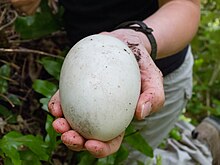Little spotted kiwi
| Little spotted kiwi | |
|---|---|

| |
| Foraging at Zealandia EcoSanctuary , Wellington
| |
| Scientific classification | |
| Domain: | Eukaryota |
| Kingdom: | Animalia |
| Phylum: | Chordata |
| Class: | Aves |
| Infraclass: | Palaeognathae |
| Order: | Apterygiformes |
| Family: | Apterygidae |
| Genus: | Apteryx |
| Species: | A. owenii
|
| Binomial name | |
| Apteryx owenii | |
| Subspecies | |
| |

| |
| The distribution of little spotted kiwi.
Predator-free islands:
Mainland:
| |
| Synonyms | |
|
List
| |
The little spotted kiwi or little grey kiwi
Taxonomy
The little spotted kiwi is a
The little spotted kiwi was first described in 1847 by John Gould from a specimen obtained by Frederick Strange and sent to England.[9] The locality is not recorded but it probably came from Nelson or Marlborough. In 1873, Henry Potts published an account of its habitats, and about this time specimens were collected in South Westland and sent to England.[2]
Description
The little spotted kiwi has a length of 35 to 45 cm (14–18 in) and the weight of the male is 0.88 to 1.36 kg (1 lb 15 oz – 3 lb 0 oz) and the female weighs 1 to 1.95 kg (2+1⁄4–4+1⁄4 lb), making it the smallest species of kiwi.
-
Illustration byJ. G. Keulemans from a work by G. D. Rowley, 1870s
-
Burrow entrance, Zealandia
The little spotted kiwi had an obligate louse that parasitized on it, Rallicola pilgrimi. In an example of conservation-induced extinction, all lice were killed while ensuring captive kiwis for survival.[11][12]
Distribution and habitat
Studies on Kapiti Island show that they prefer flax, seral, and older forest habitats. Lower numbers are found in rough grassland and scrub, indicating that either they prefer other habitats or they simply need a larger territory to support themselves in these areas.[10]
Behaviour
Little spotted kiwis eat grubs and other small insects that are found underground, and occasionally eat berries. Earthworms,
Reproduction

They nest in an excavated burrow, dug by both birds and sometimes lined with plant material. Eggs are laid from July to January. The clutch size is one to two eggs (15% have 2), which are incubated by the male for 63–76 days. Chicks stay in the nest for 2–3 weeks after hatching and require feeding for 4 weeks.[2] Little spotted kiwi eggs are the largest egg relative to the size of the bird. Its egg accounts for 26 percent of its own weight—the equivalent of a human giving birth to a six-year-old child.
Conservation
At the time it was described, the species was common on the western side of the South Island and in Marlborough. Then a regular trade in skins sprang up and large numbers were collected for European museums. Further, with the advance of European settlement, birds were killed by prospectors and others for food and their attendant dogs and cats took their toll. The species was extinct on the North Island by 1938 when the last four South Island birds were moved from
As the smallest species of kiwi, the little spotted kiwi would be very vulnerable to the main kiwi predators like cats, dogs, and
| Location | Population | Date | Trend |
|---|---|---|---|
| Hen Island | 50 | 2012 | Increasing |
| Kapiti Island | c.1200 | 2012 | Stable |
Red Mercury Island |
70 | 2012 | Increasing |
Long Island |
50 | 2012 | Increasing |
Tiritiri Matangi |
80 | 2012 | Increasing |
| Zealandia Wildlife Sanctuary | 120 | 2012 | Increasing |
| Motuihe Island | 30 | 2012 | Stable |
| Anchor Island | 20 | 2015 | Increasing |
| Chalky Island | 50 | 2012 | Stable |
| Total (New Zealand) | 1670 | 2012 | Increasing |
Citations
- ^ . Retrieved 12 November 2021.
- ^ a b c d e f Davies, S. J. J. F. (2003)
- .
- ^ Gill; et al. (2010). "Checklist of the birds of New Zealand, Norfolk and Macquarie Islands, and the Ross Dependency, Antarctica" (PDF) (4th ed.). Te Papa Press. Retrieved 22 May 2016.
- PMID 23677342.
- ^ Gotch, A. F. (1995)
- ISBN 978-1-4081-5725-1.
- ^ S2CID 243646391. Retrieved 18 August 2018.
- ^ Whittell, H. M. (1947). "Frederick Strange". The Australian Zoologist. 11: 96–114.
- ^ a b c d e BirdLife International (2008a)
- .
- ^ "Rallicola (Aptericola) pilgrimi. NZTCS". nztcs.org.nz. Retrieved 2023-08-23.
- ^ a b c "Apteryx owenii (Little spotted kiwi)". Animal Diversity Web.
- ^ BirdLife International (2008b)
General and cited references
- BirdLife International (2008a). "Little Spotted Kiwi - BirdLife Species Factsheet". Data Zone. Retrieved 6 Feb 2009.
- BirdLife International (2008b). "What's New (2008)". IUCN RedList. Archived from the original on 2007-08-28. Retrieved 4 Feb 2009.
- Davies, S.J.J.F. (2003). "Kiwis". In Hutchins, Michael (ed.). Grzimek's Animal Life Encyclopedia. Vol. 8 Birds I: Tinamous and Ratites to Hoatzins (2nd ed.). Farmington Hills, MI: Gale Group. pp. 89–90, 92–93. ISBN 0-7876-5784-0.
- Gotch, A.F. (1995) [1979]. "Kiwis". Latin Names Explained. A Guide to the Scientific Classifications of Reptiles, Birds & Mammals. London: Facts on File. p. 181. ISBN 0-8160-3377-3.
- "Little spotted kiwi". Save the Kiwi. Retrieved 20 May 2023.
External links
- BirdLife International (2023). "Species factsheet: Apteryx owenii". Data Zone. Retrieved 27 Nov 2023.




